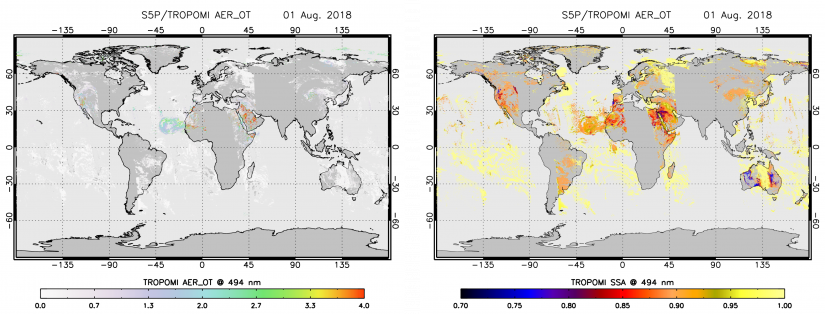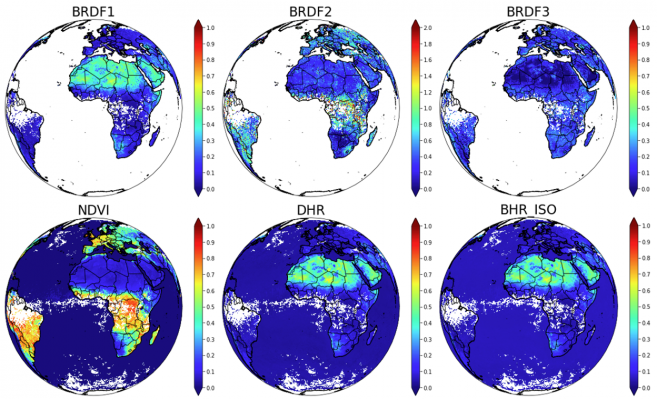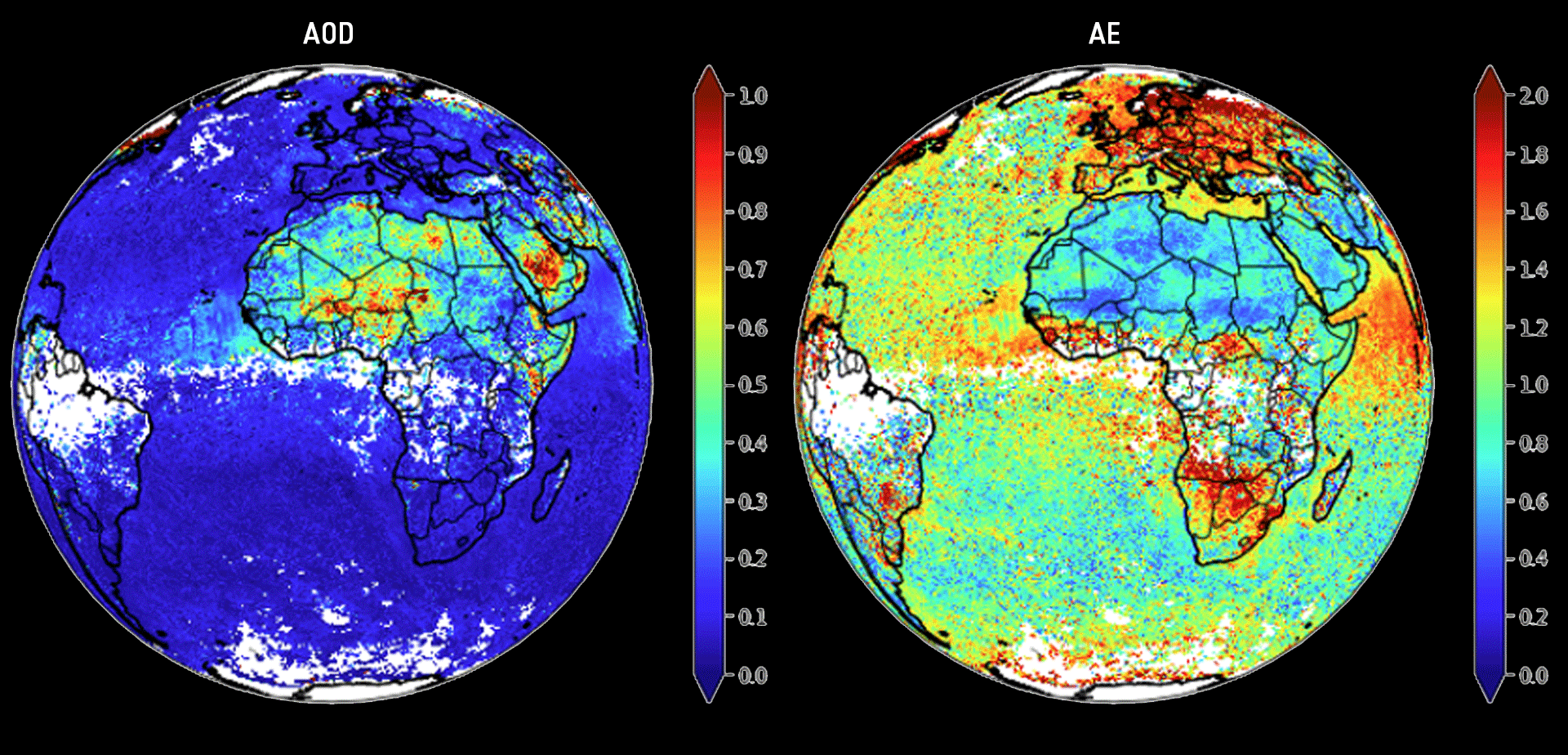A high level of innovation in algorithm development and methodological approach is the key feature of the activities performed during the ESA S5P+Innovation AOD/BRDF project.
Aerosol Optical Depth (AOD) is the single most comprehensive variable for the remote assessment of the aerosol load in the atmosphere. Atmospheric aerosols, such as aerosols from the burning of biomass, dust minerals, volcanic ash, smoke, sea salt, and particulate matter, stand out as a result of various natural and anthropogenic influences.
Aerosols are important components in the Earth’s system and have a decisive influence on global and regional climate change, as well as on air quality, human health, and cloud processes.
The reflectivity of the Earth’s surface is an important input parameter for many satellite retrievals of atmospheric composition, which implies calculating the Bidirectional Reflectance Distribution Function (BRDF). Recent developments in atmospheric remote sensing have focused strongly on deriving and implementing angular-dependent surface BRDF information (as opposed to using traditional, non-directional Lambertian surface reflectivity information), and on obtaining this information on a much higher spatial resolution than before.
The project explored the potential to achieve quantitative characterisation of aerosol properties (e.g., AOD, information about absorption and type of aerosol) as well as spectral surface BRDF information from (and for) the Sentinel-5P TROPOMI sensor.
Adaptation of heritage algorithms
One methodology approach was built on the heritage algorithms of AOD and DLER, previously applied to TOMS, GOME(-2), SCHIAMACHY, and OMI UV sensors (Tilstra et al., 2021).
Such algorithms use conventional approaches, in which surface and aerosol properties are derived for every pixel-by-pixel retrieval. Examples of the obtained aerosol and surface products using the heritage algorithm are demonstrated in Figures 1 and 2.


Application of new methodological approaches
Beyond such heritage algorithms, the state-of-the-art Generalized Retrieval of Aerosol and Surface Properties (GRASP) method has been applied to TROPOMI observations. GRASP is a recently developed (Dubovik et al. 2011, 2021) open source versatile algorithm that provides simultaneous retrieval of both aerosol and surface properties from diverse satellite and ground-based passive and active observations. GRASP retrieval is implemented as a highly advanced statistically optimized fitting of all available observations, using a multi-pixel concept in which the fitting is realized simultaneously for a large group of “pixels” (coordinated observations).


Conclusions
Overall, the S5P+I AOD/BRDF study showed rich information content of S5P TROMOMI for aerosol and surface characterization (TROPOMI Validation and Final Reports). The wide swath of S5P TROPOMI provides almost daily coverage which is crucial for full BRDF characterisation as well as for accurate separation of atmosphere and surface signals using different temporal variability of atmospheric and surface conditions. This fact together with the wide spectral range of S5P TROPOMI, covering UV, VIS, NIR, and SWIR spectra, provides new possibilities for aerosol characterisation.
In general, this project has shown the usefulness and new possibilities provided both by the GRASP and the heritage algorithms applied to the S5P TROPOMI instrument. GRASP provides high-quality products that meet the highest standards currently available and provides concepts and tools that will be beneficial for future satellite missions and scientific advancements. Furthermore, it provides a guideline for future developments of both (satellite) missions and computational resources that are necessary to retrieve geophysical parameters from the fast-growing multitude of satellite and ground-based measurements that will become available. On the other hand, heritage products like DLER and AOD can directly be applied by users and in existing algorithms that use traditional, pixel-by-pixel retrievals. The derived GRASP and heritage products are independent and complementary, are made available to a wider scientific community, and can be used for cross-validation studies.
The innovative aerosol and surface products and related documentation are available through the following links:
- https://www.grasp-open.com/products/
- https://www.grasp-open.com/products/tropomi-data-release/
- https://download-portal.apps.openshift.grasp-cloud.com/download/s5p-datapool
- https://www.temis.nl/surface/albedo/tropomi_ler.php
References
- Dubovik, O., M. Herman, A. Holdak, T. Lapyonok, D. Tanré, J.L. Deuzé, F. Ducos, A. Sinyuk, A. Lopatin. Statistically optimized inversion algorithm for enhanced retrieval of aerosol properties from spectral multi-angle polarimetric satellite observations. Atmos. Meas. Tech. 4, 975–1018, 2011.
- Dubovik, O., Fuertes, D., Lytvynov, P., Lopatin, A., Lapyonok, T., Doubovik, I., Xu, F., Ducos, F., Chen, C., Torres, B., Derimian, Y., Li, L., Herrera, M., Karol, Y., Matar, C., Schuster, G., Espinosa, R., Puthukkudy, A., Li, Z., Juergen, F., Preusker, R., Cuesta, J., Kreuter, A., Cede, A., Aspetsberger, M., Marth, D., Bindreiter, L., Hangler, A., Lanzinger, V., Holter, C., and Federspiel, C.: A Comprehensive Description of Multi-Term LSM for Applying Multiple a Priori Constraints in Problems of Atmospheric Remote Sensing: GRASP Algorithm, Concept, and Applications, Front. Remote Sens., doi: 10.3389/frsen.2021.706851, 2021.
- Litvinov P., Chen C., Dubovik, O., Bindreiter, L. TROPOMI Validation Report (VR): GRASP BRDF + AOD. Source: GRASP; issue 1.0. Date: 2021-07-01.
- Litvinov P., Chen C., de Graaf M., Tilstra G., Dubovik, O., Bindreiter L., Lanzinger V., Stammes TROPOMI Final Report (RR): GRASP BRDF + AOD. Source: GRASP; issue 1.0. Date: 2022-03-25.
- Tilstra, L. G., O.N.E. Tuinder, P. Wang, and P. Stammes: Directionally dependent Lambertian-equivalent reflectivity (DLER) of the Earth’s surface measured by the GOME-2 satellite instruments, Meas. Tech., 14, 4219–4238, doi:10.5194/amt-14-4219-2021, 2021.
- Torres O. , C. Ahn and Z. Chen: Improvements to the OMI near-UV aerosol algorithm using A-train CALIOP and AIRS observations. Atmos. Meas. Tech., 6(11), 3257, doi:10.5194/amt-6-3257-2013, 2013.

